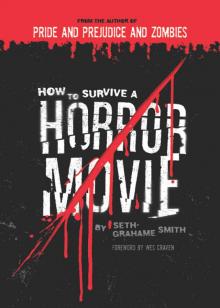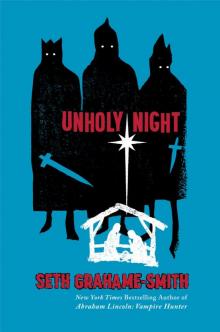- Home
- Seth Grahame-Smith
How to Survive a Horror Movie Page 4
How to Survive a Horror Movie Read online
Page 4
THE TOOLSHED ARSENAL
If you’re looking for a weapon in the Terrorverse, you can’t go wrong raiding the nearest toolshed (or garage). But choose wisely!
TAKE IT:
• Chainsaw—the horror movie defensive weapon of choice. Light and deadly.
• Hatchet—not as good as a chainsaw, but handy for cracking skulls and severing spinal cords.
• Sickle—either long- or short-handled. Great for slicing bellies open.
• Awl—penetrates foreheads and eyeballs with ease and fits nicely in your front pocket.
LEAVE IT:
• Shovel—too heavy on one end. Plus, you’re giving the screenwriter a “forced to dig your own grave” opportunity.
• Rake—what are you going to do, scratch them to death?
• Saw—we don’t have all night.
• Sledgehammer—unless you’re Mr. T, wielding something that heavy is next to impossible.
HOW TO SURVIVE SUMMER VACATION
Ah, to be young in the summer. To wake up around noon on a glorious July day, the birds singing on your windowsill, a soft breeze rustling the leaves of the oak you’ve climbed a thousand times. The world is yours. Time is limitless.
Only it isn’t. This isn’t real life, it’s a horror movie, where long summer days begin with singing birds and end with your throat getting slit in the woods. When you’re a teen (or young adult) on summer vacation, every day is the last day of the rest of your life. That is, assuming you make the same stupid mistakes that young horror movie characters always seem to make.
1. STAY AWAY FROM CABINS. Cabins are the bug zappers of the horror movie universe—a place where the more gullible of our species are weeded out in one gruesome instant. “Hey, a cabin. That looks like a nice place to spend some OH GOD MY INTESTINES ARE ON THE FLOOR!” And like the bugs that keep flying toward that pretty light, people who decide to spend their summers in a secluded, run-down cabin have learned nothing from history and are therefore doomed to repeat it. The rule is simple: If you enter a cabin—any cabin, anywhere in the world—you will be dead within 24 hours. Guaranteed.
2. DON’T GO TO SLEEPAWAY CAMP. What, pray tell, has more cabins than a sleepaway camp? “Sure, I’m in a horror movie, but I really don’t see the problem with hanging around a bunch of cabins in the middle of the woods—a bunch of cabins run by teenagers who spend their time smoking dope and humping.” Are you crazy? No institution has a higher per-capita murder rate. For example, a high school of 1,000 students can expect an average per-film loss of seven to eight students, or less than 1 percent. A sleepaway camp of 40 campers and counselors, however, can expect the same per-film losses. That’s a murder rate of 20 percent! Any horror movie character who willingly attends one of these death camps is making the screenwriter’s job so insanely easy, they should get shared credit.
3. DON’T TAKE A ROAD TRIP WITH YOUR FRIENDS. There are only three things that can happen when young people pile into a car:
Someone insists they know a great shortcut. This leads them to an eerily quiet town that’s not on any map. Suddenly, something goes wrong with the car (all horror movie vehicles have sensors that stop the engine when they detect a combination of evil and isolation). Stranded, they’re “rescued” by someone who promptly butchers them, wraps the choice cuts of meat in plastic, and stores them in their roadside diner’s walk-in freezer.
They run someone over. Inevitably they decide to ditch the body and keep it a secret, and they spend the rest of the movie getting picked off like scabs.
They safely reach their destination. Except the destination is a cabin in the middle of nowhere.
4. PONT GO BACKPACKING OVERSEAS. Until recently, Europe was a fairly safe place for students to blow off steam between semesters. With the exception of England (werewolves) and countries ending in -ania (vampires), the worst you might encounter were haunted castles that, to be honest, were more charming than scary. But with more horror films choosing Europe as their location, those colloquial haunts are fast becoming nightmarish bloodbaths. Today’s backpackers have to be on the lookout for human traffickers, dog-killing psychopaths, even spell-casting preteens. Australia is also becoming increasingly dangerous for foreigners. In the 1980s, meeting a knife-wielding loner in the Outback was quirky and romantic. These days, it’s fatal.
But the most dangerous international destination for Western travelers is Japan. With so many horror flicks coming out of the land of the rising sun, it’s best to treat the entire island as one gigantic cemetery. The only place you’re safe is in the heart of Tokyo, which (so far) seems reserved for coming-of-age romances, street racing movies, and OH GOD a giant fire-breathing lizard!
5. BORROW SUMMER ACTIVITIES FROM OTHER GENRES. Sure, there are plenty of things you can’t do on your horror vacation, but does that mean you’re condemned to a summer of Friends reruns? Your break can actually be quite fulfilling, especially if you borrow a few activities from your favorite non-horror films:
Go on a life-affirming quest with some child stereotypes. Perhaps you could follow an old treasure map or walk down the train tracks in hopes of seeing your first dead body. Just make sure your posse has at least one fat kid, one “bad” kid, and one sensitive intellectual with (1) recently divorced parents or (2) a recently deceased older brother.
Fall for the new neighbor boy or girl who dies in the second act. You’ll laugh. You’ll cry. You’ll still be alive for the funeral scene at the end of the movie.
Save some land from a bunch of developers. Nothing stops urban sprawl in its tracks like a few kids who still believe in a little thing called “home.”
COMPELLING PHYSICAL EVIDENCE WILL LEND CREDIBILITY TO YOUR STORY.
HOW TO CONVINCE THE SKEPTICAL LOCAL POLICE
If teens are heroes and slashers are villains, then cops are comic relief, if only for their steadfast refusal to acknowledge that anything’s wrong no matter how much evidence you throw their way. Why is it so hard for the sheriff to believe someone saw a masked killer in the woods when there’s been a masked killer roaming those woods for 25 years? Imagine how refreshing it would be if a group of teenagers could report something to the cops without being dismissed as pranksters or druggies? Sadly, those sworn to protect and serve the horror universe have a hard time getting motivated to do so. And that’s why enlisting their help takes some skill:
1. Remain calm. The minute you show even the slightest bit of excitability, you’ll be considered hysterical, and nothing you say will be believed.
2. Provide compelling physical evidence. A bloody knife, soiled clothing, or—best of all—a severed body part.
3. Use reverse psychology. “Ah, it’s probably nothing. I mean, sure, I watched that big fella drag that boy off into the forest, but I’d hate to see you go out there on some wild goose chase.”
4. Lie. If you want the sheriff to check something out, give him an incentive. Tell him that his wife was seen there partying with members of a biker gang—whatever it takes to get him on site.
WHAT TO DO IF YOU DID SOMETHING LAST SUMMER
1. Ask yourself, “What did I do?” Last summer could have been ages ago. What? You’re supposed to remember every little thing you did between June and August? Chances are it wasn’t something innocuous. The filmmakers have to hang the entire premise of the movie on one thing—one action taken by you, the character. Things like that tend to stick out in the memory banks.
Things You Did Last Summer that Aren’t Movie-Worthy:
• Cheat on your diet.
• Sneak store-bought candy into a movie theater.
• Have sex on the football field.
• Pool hop.
• Use illegal P2P file-sharing networks.
Things You Did Last Summer that Are Movie-Worthy:
• Cover up a manslaughter.
2. Determine if anyone knows what you did. If you get a letter from someone claiming they know what you did, chances are someone knows. Likewise, if you h
ad accomplices who also did what you did, it’s likely that they know, too. It’s recommended that you kill any accomplices as a means of reducing the number of people who know what you did.
3. If someone knows what you did, fess up. Admit to the crime, and do the time. Yes, being in a prison movie isn’t roses, but it beats the hell out of being a victim in a horror movie.
HOW TO SURVIVE A NIGHT OF BABYSITTING
In the real world, babysitting is a groovy way for young people to learn responsibility (and earn a little pocket money).
In the Terrorverse, it’s a plot device used to kill teenagers.
Babysitters are the juiciest of all slasher bait—more attractive than drunk gravediggers or horny campers. As we’ve learned, horror flicks (especially slashers) are made for teenaged ticket buyers, and teens can identify with the tensions of babysitting. You’re away from home. You can’t bail at the first sign of trouble. Devils and angels duke it out on your shoulders: “Don’t get high tonight.” “C’mon … invite him over—he’s so cute!” And then what happens? The power goes out. You try the phone … nothing. Suddenly, you remember that news report. Something about a string of murders. Footsteps upstairs. Kids missing from their beds. And faster than you can say “closed casket,” you join a long list of sliced-up sitters. Unless …
1. KNOW WHEN TO SAY “NO.” If you have half a brain in your head,* the answer is always “no.” In horror movies, babysitting is basically suicide at seven bucks an hour. It’s a dangerous game, and to quote one of my favorite passages from the Book of Joshua (the supercomputer in WarGames, not the apostle), “The only way to win is not to play.” And yet for many teenagers, the desire for extra mall cash is stronger than the will to live. Therefore, it’s important that whippersnappers be able to distinguish the really, really dangerous babysitting jobs from the 100-percent-chance-of-getting-your-throat-sliced-open babysitting jobs. If the offer includes any of the following, turn it down. It’s a guaranteed death sentence.
It’s more than two blocks from home. Anything beyond shouting or sprinting distance is too far.
There’s a storm in the forecast. Thunderstorms equal power or phone outages and opportunities for the director to use the old “lightning flash reveals the killer in the window” bit. Snowstorms equal broken-down vehicles and easily followed tracks.
One of the children is blind, deaf, or mute. It seems cruel, but remember: This isn’t the real world. In horror movies, children with some kind of sensory deprivation or disability are often portrayed as creepy.
There’s an escaped __________________ on the loose. Any noun you can imagine in that blank space is reason enough to skip the gig, with the possible exception of “pony.”
2. MAKE YOUR EMPLOYERS SIGN A BABYSITTING RIDER. A rider is a contract that specifies a list of perks. A smart sitter will craft one that ensures maximum survivability. Only work for employers who meet its terms. Some suggestions to pass along to your lawyers:
Power. Employer will provide a fully fueled backup generator that can be started without leaving the house or going into the basement.
Communication. If Babysitter attempts to contact Employer’s cell phone at any time and gets no answer, Babysitter has the right to abandon the kids and run home.
Punctuality. If employer is more than sixty (60) seconds late for the agreed return time, Babysitter has the right to abandon the kids and run home.
Temptation. Employer will leave no unlabeled videos, alcoholic beverages, pornographic materials, or anything that might tempt Babysitter into committing lewd, unsavory, or potentially curse-invoking behavior anywhere in the home.
Security. Employer will provide doors and windows that can be securely locked from the inside, a professionally installed security system, and at least two (2) easily accessible, fully loaded firearms.
3. BUILD A FORTRESS. With no storms in the forecast, no escaped mental patients on the news, and your parents within shouting distance (and assuming your employer has met all the terms of your rider), the babysitting can begin. But before you even think about making the kids a snack, priority one is turning a small area of the house into an impregnable fortress. This “no in or out” zone usually includes the kitchen, living room, and at least one bathroom, and never encompasses more than one floor.
Start by closing (and, if possible, locking) all the doors on the edge of your perimeter and hanging little bells on the knobs. Confirm that all windows are closed, shut any drapes or blinds, and turn on every light within reach. Next, turn the TV on and tune it to a local station, in case there are any breaking reports of nearby murders, escapes, or storms. If the basement door falls within your perimeter, nail at least three big wooden planks across it. Finally, set the alarm, check the phone for a dial tone, and tether yourself to each child with a length of rope.
4. DON’T DO ANYTHING EVEN REMOTELY IRRESPONSIBLE. The minute you take your eyes off those kids—the minute you choose indulgence over vigilance—you’re dead. Here’s a rule of thumb: If you wouldn’t do it in front of the parents, don’t do it. Some common babysitter pitfalls include:
• Inviting your boyfriend or girlfriend over.
• Raiding the liquor cabinet.
• Watching the parents’ porn collection.
• Using the phone for endless personal, gossip-filled calls.
• Leaving the kids to entertain themselves.
5. NEVER, EVER, EVER ANSWER THE PHONE. Regardless of what the caller ID says, let it ring. If it’s the parents, they’ll leave a message. If it’s one of your friends, you shouldn’t be chatting with them anyway. But we both know it’s not the parents or your friends. Why? Because this is a horror movie. And in a horror movie, it’s always the killer, who is always calling from another part of the house. Your screenwriters are begging you to answer that phone. They need you to answer it, so their villain can send chills down your spine with some clever one-liner. All the more reason to let it go to voicemail.
6. CHECK YOUR CURIOSITY AT THE DOOR. What I really mean is stupidity. Check your stupidity at the door. Here are three situations you might face during a night of babysitting, each with the (soon to be dead) “curious” person’s and the (might make it to the end credits) “incurious” person’s response:
ONE OF THE WINDOWS IS RATTLING.
Curious: You decide to check it out, despite the fact that you swear you remember closing it.
Incurious: You set fire to the house, abandon the kids, and run home screaming.
THE CHILDREN DISAPPEAR.
Curious: Panicked, you search every nook of the house while calling out their names.
Incurious: You continue reading your Bible and wait for them to turn up.
SOMEONE KNOCKS ON THE DOOR, ASKING TO USE THE PHONE TO REPORT AN ACCIDENT.
Curious: You open the door a crack to get a better look at the stranger.
Incurious: You empty a full clip through the door, reload, open it, and empty another clip into whomever or whatever is lying motionless on the front porch.
WHEN BABYSITTING, YOU MUST TRANSFORM YOUR CLIENT’S PLEASANT SUBURBAN HOME INTO AN IMPREGNABLE FORTRESS.
KNOW YOUR HARBINGERS OF IMPENDING DOOM: BOOBIES
Not the sea birds found primarily near warm waters—the fatty deposits that grace the chests of mature human females. Jugs. Melons. And while it’s hard to imagine anything bad coming from something so good, there’s an unfortunate horror movie phenomenon, Titsonics, that turns boobies into bouncy death traps.
In the Terrorverse, young women’s breasts emit a high-frequency sound (measured in mammahertz) that only horror movie villains can hear. The sound attracts them—not because they want a peek, but because they know that naked breasts indicate the presence of at least one highly distracted or highly vulnerable victim. The bigger the boobies, the louder the noise. And when those boobies are squeezed (say, by the fumbling hands of a young male), they get louder still.
Therefore, the only safe boobies are untouched, well-cov
ered boobies. And well-covered means buried beneath enough clothing to muffle their sound (i.e., no tank tops). In fact, the ideal outfit for a young woman would be a parka, over a ski jacket, over two sweatshirts, over two bras—with the nipples duct taped for good measure. But take heart, ladies. The moment you hit 23, your Titsonic profile becomes dramatically lower. And once you have a kid, it disappears forever.
DRESSING CONSERVATIVELY (LEFT) WILL GUARANTEE A LONG AND PROSPEROUS LIFE. BUT PUT ON A LOW-CUT TOP (RIGHT) AND YOU’RE SCREWED.
HOW TO STAY AWAKE FOR A WEEK
Staying awake and staying alive are often synonymous in horror movies. Perhaps your dreams have become the killing fields of a demonic slasher. Maybe you’ve been stranded on an alien-infested planet or cornered in a house that’s surrounded on all sides by zombies. In any case, not an ideal time to hop the choo-choo to Sleepytown. And since there’s no telling when the rescue party may arrive (or when it’ll be safe to dream again), a horror movie survivor has to be able to push the outer limits of sleep deprivation. Believe it or not, the world record for going without sleep is held by a teenager named Randy Gardner. In 1964, he stayed awake for 264 straight hours—exactly 11 days. All you’re required to do is a measly seven. And if you follow these steps, you might just make it.
1. TRY TO JUMPSTART A MONTAGE. What’s the easiest way to stay awake for a week? Make it fly by in the span of a single upbeat song. Musical montages aren’t common in the horror universe, but they aren’t out of the question either. After all, this is still a movie—and in movies, it’s possible to condense lots of events and time into a short series of illustrative shots, one dissolving into the next. Since these shots are rarely accompanied by dialogue, they’re usually set to music—a song that’ll boost sales of the soundtrack, for instance.

 PRIDE AND PREJUDICE AND ZOMBIES
PRIDE AND PREJUDICE AND ZOMBIES Abraham Lincoln: Vampire Hunter
Abraham Lincoln: Vampire Hunter The Last American Vampire
The Last American Vampire How to Survive a Horror Movie
How to Survive a Horror Movie Unholy Night
Unholy Night